
Sioux Beadwork
Western Sioux Beadwork - Designs and Colors
by Chuck Bousquet
originally
published as CIHA Indian Craft Series No. 1020
The following information is a very, very brief resume on the Western Sioux beadwork designs and colors. It is assumed that Sioux-style hobbyists are already aware that the beadwork is done in lazy stitch directly on the item they are going to decorate (with a few exceptions such as shirt and legging strips which are beaded on separate pieces of leather and then the piece is sewn onto the particular item in the appropriate place). With this assumption, therefore, let’s get into the designs and colors with just a little background history first.
Before glass beads were introduced to the Plains by traders, the Sioux had perfected the art of using porcupine quills to decorate their clothes and belongings. The quills were dyed red, bright yellow, weak blue, bright orange, weak green and purple. Vegetable dyes were used until about 1880 when the whites traded aniline dyes and the colors became brighter and more varied. This quill-work was done on pipebag fringe, kneebands, bustle ties and other large objects using the simple wrapping technique; the sewing and weaving methods were used for moccasins, pipes and feather decorations.
By the late 1880’s to 1890’s, the Sioux had a style of beading using certain colors and designs that were different than any other tribe. There are many techniques involved in making beadwork look like the style of the tribe you desire to represent. Not only colors and designs, but the method of beading, are very important. The following are guidelines to help you make your finished beadwork look Sioux.
As mentioned above, the Sioux had a distinct beadwork style of their own. Their designs were mostly geometric with some men’s beadwork that represented life around them including figures, horses and birds. After the 1890’s more intricate triangles and spidery designs were introduced. If you carefully examine photographs and the actual articles of Sioux beadwork, you will note the following:
- Designs geometric and usually
symmetrical.
- Designs spread out to cover most of the
background.
- Many lines and geometrical figures held
together by a central design.
- Triangles and lines with three-pronged
forks.
- Large spaces of background broken up
with lines and crosses.
- Small squares added to crosses, lines
and larger squares.
- Small designs added to give a finished look to the whole design.
Many times a hobbyist will do a piece of beadwork and the designs will be perfect but the colors will be wrong, or vice-versa. This is because the person failed to study photographs and/or the real thing, and has simply copied diagrams of designs only. Here are a few simple rules about colors, then an analysis of each color and its proper use:
- The Sioux beaded mostly on a white
background.
- The designs were outlined with a dark
color to contrast with the white.
- Colors often used together were green
and yellow (Italian “greasy yellow”), rose and yellow, and rose with blue
and green.
- Avoid using similar colors together such
a light color or pastel on a white or light background.
- Several shades of blue or green are
seldom seen on the same piece.
- Most common color sequence used in the classic period is blue, yellow, red and green, in that order. As Conn states in his article (see reference 3.) Sioux beadwork colors were limited mainly to red, white and blue, plus one or two other colors and ...... the Sioux were the only people who could use red, white and blue so often without making it look overly-patriotic.”
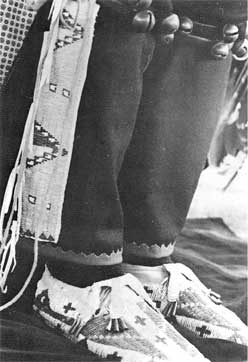
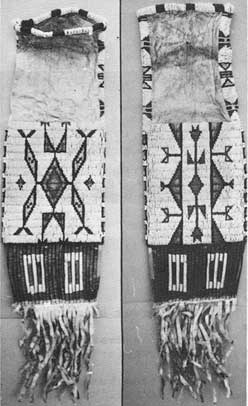
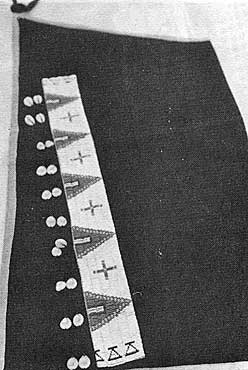
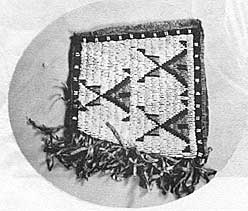
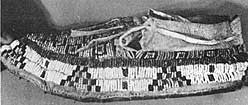
- White: A true flat white as background
—covers most areas broken by lines and block designs. Sometimes a milky
or “pearl” white was used. Light blue background seems to be a more modern
technique. It was sometimes used for very small squares in a design.
However, light blue was a fairly common background color in Sioux dresses,
cradleboards, tobacco bags, pouches and some legging strips.
- Dark blue: Dark (almost black) or royal
blue used in outlining large block designs, fine lines, crosses, borders.
- Light blue: Almost turquoise; used for
inside of designs.
- Periwinkle blue: A medium, sort of
purplish blue, darker than light blue but not as dark as royal blue. Used
for medium size blocks.
- Green: Medium, slightly dull green. Used
for inside of designs.
- Dark green: Very dark, transparent. For
large blocks of color with or without darker border. Used quite often on
moccasins.
- Reddish brown: For borders and small
squares within lighter blocks of color, and thin lines and designs
extending from basic blocks. Interchangeable with dark blue.
- Yellow: Pale, dull Italian “greasy
yellow.” For semi-large blocks of color and for center, or near centers
of designs. This is the old-time Sioux yellow. The modern is a flat,
bright yellow.
- Metallic: Silver and gold colored
faceted metallic beads for very small, intricate squares in center of
designs. Only one or two rows wide; usually bordered by dark color; ends
of crosses.
- Rose (Red): White center red; a
transparent red bead with white center through hole. Gives a rose or
pinkish effect. Used to outline metallic beads and for thin lines, small
squares and triangles, The modern color is a true red. A dark ruby red
was used occasionally also.
- Miscellaneous colors: Dull orange appeared on some beadwork but not very often. Pink was very rarely seen and black was practically never used.
To sum up, remember that the best place to find your proper Sioux designs and colors is from the real thing. Go to museums, trading posts or Indian art and culture shows/exhibits. Examine the actual items, particularly the kind of item you are mainly interested in or working on. Check the designs and colors. Take photos of them or make sketches and be sure to record the colors you see. Then do yours that way. Don’t try to experiment. Check closely color photos and pictures, too. The Sioux have a definite style and if you’re a Sioux-style enthusiast do it the Sioux way
References:
- “Old Time Sioux Dancers” book by M.S. Tucker (A.I.C.C.)
- “Quill and Beadwork of the Western Sioux” book by Carrie A, Lyford (U.S.
Dept. of the Interior)
- ‘Western Sioux beadwork” article by Dick Conn published in Vol. VI, No. 9 & 10, Summer 1960, American Indian Hobbyist.
Copyright © California Indian Hobbyist Association & Jerry Smith
Copyright © 2003-2019 Matoska Trading Company Inc